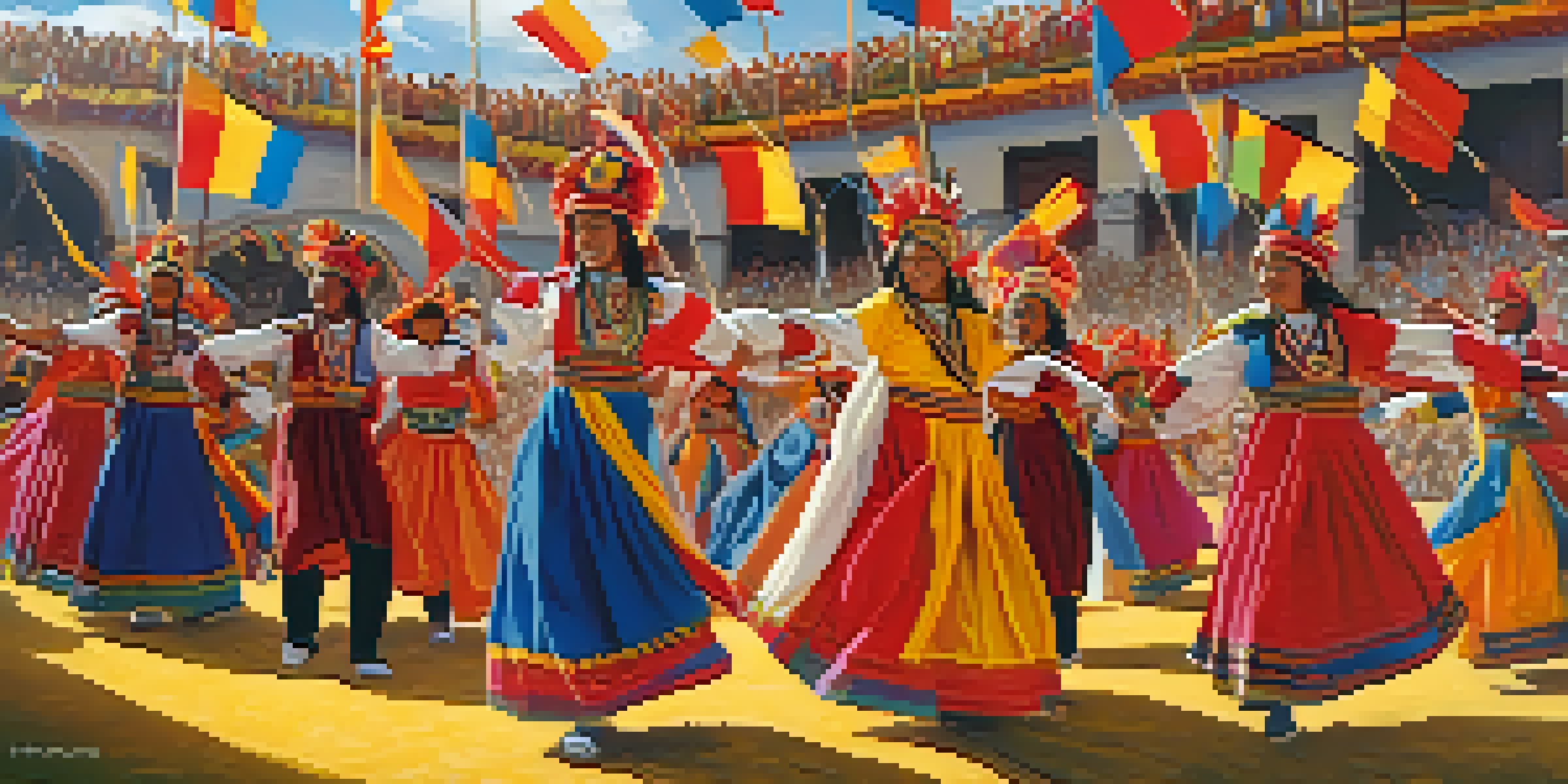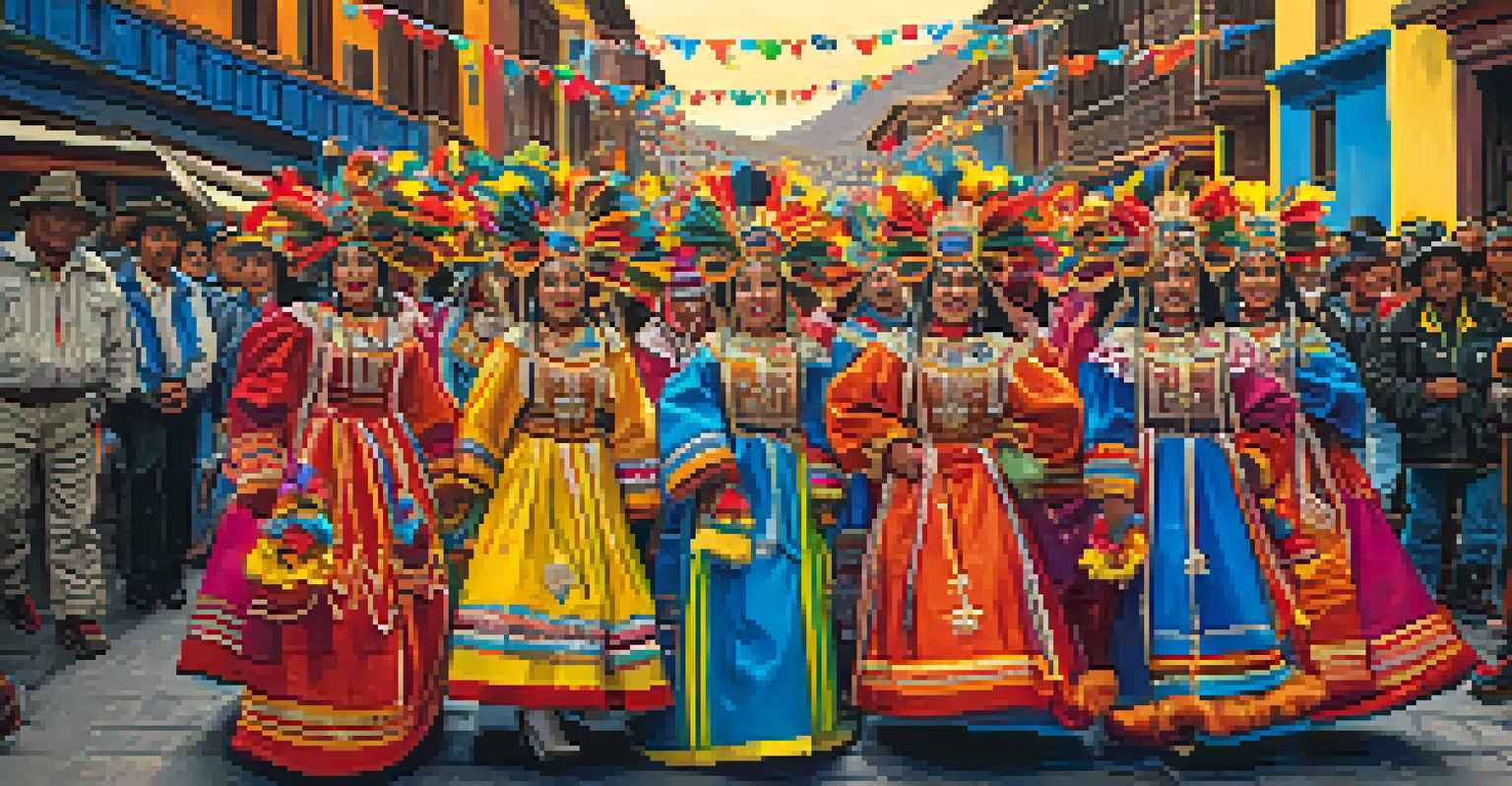Celebrating Peruvian Folklore: Festivals of Myths and Legends

The Heart of Peru: Folklore and Its Significance
Peruvian folklore is a vibrant tapestry woven from centuries of history, culture, and tradition. It's a reflection of the diverse indigenous peoples, colonial influences, and the natural beauty of the landscape. This rich heritage comes alive through stories, music, and dance, all of which play a vital role in the country's festivals.
Folklore is the living expression of a culture's history, values, and beliefs.
Folklore serves not just as entertainment but also as a means of preserving the past. Each tale often carries a moral lesson or cultural significance, making it essential for younger generations to understand their roots. By celebrating these festivals, Peruvians honor their ancestors and the myths that shaped their identity.
Festivals grounded in folklore provide a unique opportunity for communities to come together. They foster a sense of belonging and continuity, allowing people to celebrate their shared history and values. This connection to culture is especially important in today's fast-paced world.
Inti Raymi: The Festival of the Sun
Inti Raymi, or the Festival of the Sun, is one of the most significant celebrations in Peru, held every June 24th in Cusco. This ancient Incan festival honors Inti, the Sun God, who was believed to bring life and prosperity. The event attracts thousands of visitors eager to witness vibrant parades, traditional music, and dramatic reenactments.

The festival’s origins date back to the Inca Empire when it was celebrated as a way to ensure a good harvest. Participants don elaborate costumes, and the city transforms into a lively stage showcasing traditional dances and rituals. The highlight is a ceremonial offering to the sun, symbolizing gratitude for its warmth and light.
Peruvian Folklore: Cultural Heritage
Peruvian folklore is a vibrant tapestry that preserves the history, traditions, and moral lessons of diverse communities.
Inti Raymi is not just a historical event; it's a way for modern Peruvians to connect with their heritage. The enthusiasm and community spirit during the festival are palpable, as locals and tourists alike join in the festivities. It’s a spectacular reminder of the enduring legacy of the Incas and their connection to nature.
The Colorful Carnival of Cajamarca
The Carnival of Cajamarca is a delightful explosion of color, music, and laughter, celebrated in February. This lively festival is famous for its vibrant parades, where people don elaborate costumes and engage in friendly water battles. It’s a unique blend of pre-Columbian and Spanish traditions, showcasing the region's rich cultural history.
Food is our common ground, a universal experience that brings us together.
During the Carnival, locals participate in various activities, including dance competitions, games, and traditional music performances. The atmosphere is infectious, as everyone comes together to celebrate the joy of life through laughter and fun. Each day of the carnival brings new surprises, making it an unforgettable experience for participants and spectators alike.
This celebration highlights the importance of community and connection, as families and friends gather to enjoy the festivities. The Carnival of Cajamarca not only entertains but also strengthens social bonds and fosters a sense of unity among its participants. Ultimately, it serves as a reminder of the joy and resilience of the Peruvian people.
Puno's Fiesta de la Virgen de la Candelaria
Celebrated in early February, the Fiesta de la Virgen de la Candelaria is one of Peru's most important religious festivals, particularly in Puno. This vibrant celebration honors the Virgin of Candelaria, the patron saint of the city, and attracts thousands of devotees and tourists. The festival is a mesmerizing blend of spirituality, music, and colorful costumes.
Participants engage in traditional dances, including the famous Diablada and Morenada, which depict historical and mythical themes. The event is marked by elaborate parades, where dancers and musicians fill the streets with life and energy. The beauty of this festival lies in its ability to merge indigenous beliefs with Catholic traditions, creating a unique spiritual experience.
Festivals Unite Communities
Festivals like Inti Raymi and the Carnival of Cajamarca foster a sense of belonging and continuity among participants, celebrating shared heritage.
The Fiesta de la Virgen de la Candelaria is more than just a religious observance; it’s a celebration of community and identity. Families often prepare for months, crafting costumes and practicing dances, showcasing their pride in their heritage. The festival fosters a deep sense of belonging, as people come together to honor their culture and faith.
The Enchanting Legends Behind Peruvian Festivals
Many of Peru's festivals are steeped in enchanting legends that capture the imagination. These tales often explain the origins of the celebrations, intertwining myth with historical events. For instance, the story of the Inca's reverence for the sun during Inti Raymi reflects the agricultural importance of the season.
Legends serve as storytelling tools that preserve cultural values and teach important lessons. They often feature heroic figures, mystical creatures, and moral dilemmas, engaging audiences and inspiring generations. Festivals become a living narrative, where participants enact these stories, ensuring they remain alive in the collective memory.
By embracing these legends, Peruvians foster a deep connection to their ancestors and the land. Festivals become a stage for these stories, allowing communities to come together and celebrate their unique identity. In this way, folklore is not merely a relic of the past but a vibrant part of contemporary life.
Food and Drink: A Culinary Journey Through Festivals
No celebration in Peru is complete without its delicious array of traditional foods and drinks. Each festival showcases unique culinary delights that reflect the region's culture and history. From hearty stews to sweet treats, the flavors of Peru add an extra layer of joy to the festive atmosphere.
During Inti Raymi, for example, locals prepare dishes like pachamanca, a traditional meat and vegetable dish cooked in an underground oven. Similarly, the Fiesta de la Virgen de la Candelaria features an abundance of local specialties, including quinoa dishes and sweet desserts like picarones. The emphasis on sharing food strengthens community bonds and highlights the importance of hospitality.
Music and Food Enhance Celebrations
Traditional music, dance, and food play crucial roles in Peruvian festivals, enriching the experience and strengthening community bonds.
Food at these festivals is more than just sustenance; it symbolizes unity and celebration. Families and friends gather around tables, sharing stories and laughter over home-cooked meals. This culinary journey through Peruvian festivals not only delights the palate but also nourishes the spirit of togetherness.
The Role of Music and Dance in Celebrations
Music and dance are at the heart of Peruvian festivals, infusing them with energy and life. Traditional instruments like the charango, cajón, and pan flute create melodies that resonate with the spirit of the celebrations. Each festival has its own unique rhythms and dances, reflecting the cultural diversity of the country.
During the Carnival of Cajamarca, for instance, lively rhythms encourage spontaneous dancing, while the solemnity of the Fiesta de la Virgen de la Candelaria embraces more traditional, reflective music. These performances serve as expressions of joy, spirituality, and cultural pride, inviting everyone to join in the celebration.

Through music and dance, communities tell their stories, honor their ancestors, and express their emotions. It’s a powerful form of communication that transcends words, connecting people of all ages. In this way, the role of music and dance in Peruvian festivals is not just entertainment but a vital part of cultural identity.